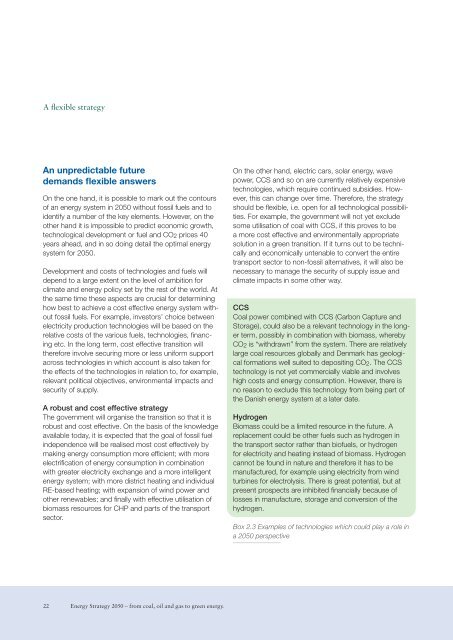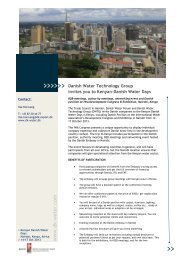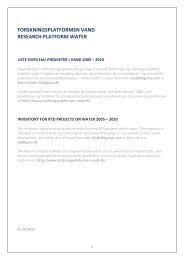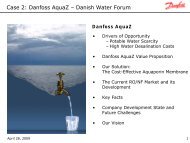energy strategy 2050 - Energy Europe
energy strategy 2050 - Energy Europe
energy strategy 2050 - Energy Europe
Create successful ePaper yourself
Turn your PDF publications into a flip-book with our unique Google optimized e-Paper software.
A flexible <strong>strategy</strong><br />
An unpredictable future<br />
demands flexible answers<br />
On the one hand, it is possible to mark out the contours<br />
of an <strong>energy</strong> system in <strong>2050</strong> without fossil fuels and to<br />
identify a number of the key elements. However, on the<br />
other hand it is impossible to predict economic growth,<br />
technological development or fuel and CO 2 prices 40<br />
years ahead, and in so doing detail the optimal <strong>energy</strong><br />
system for <strong>2050</strong>.<br />
Development and costs of technologies and fuels will<br />
depend to a large extent on the level of ambition for<br />
climate and <strong>energy</strong> policy set by the rest of the world. At<br />
the same time these aspects are crucial for determining<br />
how best to achieve a cost effective <strong>energy</strong> system without<br />
fossil fuels. For example, investors’ choice between<br />
electricity production technologies will be based on the<br />
relative costs of the various fuels, technologies, financing<br />
etc. In the long term, cost effective transition will<br />
therefore involve securing more or less uniform support<br />
across technologies in which account is also taken for<br />
the effects of the technologies in relation to, for example,<br />
relevant political objectives, environmental impacts and<br />
security of supply.<br />
A robust and cost effective <strong>strategy</strong><br />
The government will organise the transition so that it is<br />
robust and cost effective. On the basis of the knowledge<br />
available today, it is expected that the goal of fossil fuel<br />
independence will be realised most cost effectively by<br />
making <strong>energy</strong> consumption more efficient; with more<br />
electrification of <strong>energy</strong> consumption in combination<br />
with greater electricity exchange and a more intelligent<br />
<strong>energy</strong> system; with more district heating and individual<br />
RE-based heating; with expansion of wind power and<br />
other renewables; and finally with effective utilisation of<br />
biomass resources for CHP and parts of the transport<br />
sector.<br />
On the other hand, electric cars, solar <strong>energy</strong>, wave<br />
power, CCS and so on are currently relatively expensive<br />
technologies, which require continued subsidies. However,<br />
this can change over time. Therefore, the <strong>strategy</strong><br />
should be flexible, i.e. open for all technological possibilities.<br />
For example, the government will not yet exclude<br />
some utilisation of coal with CCS, if this proves to be<br />
a more cost effective and environmentally appropriate<br />
solution in a green transition. If it turns out to be technically<br />
and economically untenable to convert the entire<br />
transport sector to non-fossil alternatives, it will also be<br />
necessary to manage the security of supply issue and<br />
climate impacts in some other way.<br />
CCS<br />
Coal power combined with CCS (Carbon Capture and<br />
Storage), could also be a relevant technology in the longer<br />
term, possibly in combination with biomass, whereby<br />
CO 2 is “withdrawn” from the system. There are relatively<br />
large coal resources globally and Denmark has geological<br />
formations well suited to depositing CO 2 . The CCS<br />
technology is not yet commercially viable and involves<br />
high costs and <strong>energy</strong> consumption. However, there is<br />
no reason to exclude this technology from being part of<br />
the Danish <strong>energy</strong> system at a later date.<br />
Hydrogen<br />
Biomass could be a limited resource in the future. A<br />
replacement could be other fuels such as hydrogen in<br />
the transport sector rather than biofuels, or hydrogen<br />
for electricity and heating instead of biomass. Hydrogen<br />
cannot be found in nature and therefore it has to be<br />
manufactured, for example using electricity from wind<br />
turbines for electrolysis. There is great potential, but at<br />
present prospects are inhibited financially because of<br />
losses in manufacture, storage and conversion of the<br />
hydrogen.<br />
Box 2.3 Examples of technologies which could play a role in<br />
a <strong>2050</strong> perspective<br />
22<br />
<strong>Energy</strong> Strategy <strong>2050</strong> – from coal, oil and gas to green <strong>energy</strong>.
















